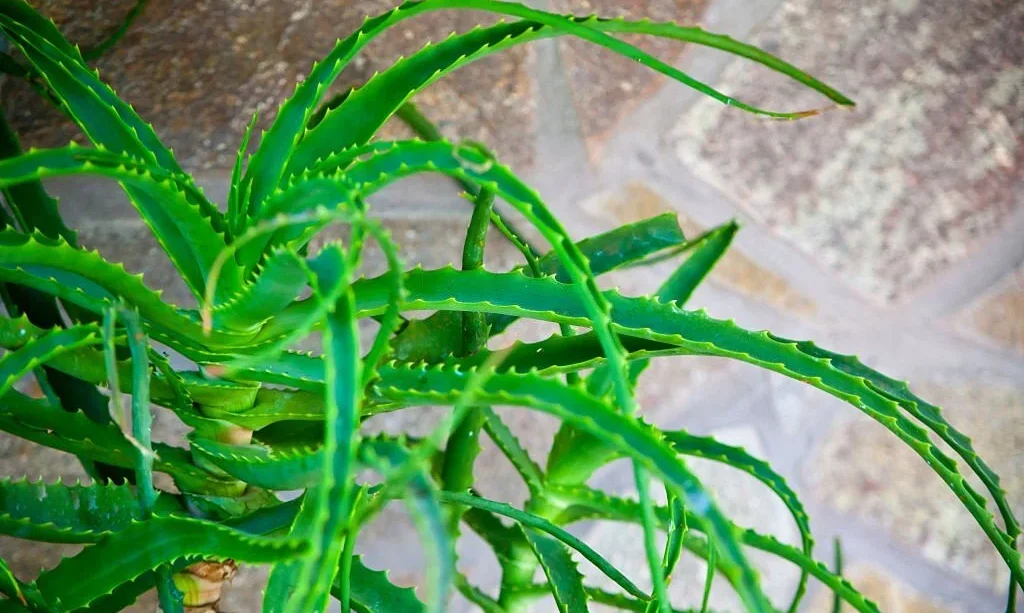Having a healthy and upright aloe plant is not only visually appealing but also a sign of its overall well-being. However, if your aloe plant is drooping or leaning, you may wonder why it’s not standing up straight. In this simple guide, we’ll explore the reasons behind an aloe plant not standing up and provide insights into the structure of an aloe plant. By understanding the unique characteristics of aloe plants, you’ll be better equipped to address any issues and help your aloe plant regain its upright posture. Let’s dive in and uncover the secrets of aloe plant structure!
- GROW YOUR OWN SUCCULENT GARDEN- Perfect to feed a wide variety of potted desert plants such as aloe vera, jade plant, hoya, and African violet
- RICH CONCENTRATE OF NUTRIENTS- Pack full of vital plant elements for root growth such as nitrogen, phosphate, and potassium, dilute 1 teaspoon per gallon of water
- FAST ACTING- Superior to powder or granular slow release fertilizers this liquid based plant food is absorbed by plant roots faster and more efficiently
- PROFESSIONALLY PRODUCED AND BOTTLED IN THE USA- We mix and professionally bottle our high quality fertilizer formula right on our family farm
- PERFECT FOR ALL DRY LOVING PLANTS – Use along side well draining potting mix to promote a broad root network in all houseplant succulents, watch your succulent and cacti thrive!
Aloe Plant Structure
Aloe plants have a unique structure that contributes to their upright growth habit. Here’s what you need to know:
- Rosette Form: Aloe plants typically grow in a rosette form, with fleshy, succulent leaves arranged in a spiral pattern. The leaves originate from a central stem or crown.
- Leaf Anatomy: Aloe leaves are thick and fleshy, designed to store water and nutrients. They are made up of an outer protective skin, an inner gel-like substance, and a network of vascular tissues that transport water and nutrients throughout the plant.
- Supportive Role: Aloe leaves play a crucial role in supporting the plant’s upright posture. They provide structural integrity and help the plant stand tall.
By understanding the structure of an aloe plant and the importance of its leaves, you’ll gain insights into why your aloe plant may be experiencing difficulty in standing up straight. In the following sections, we’ll explore potential reasons behind a drooping or leaning aloe plant and how to address them.
Insufficient Light
Light plays a crucial role in the health and posture of your aloe plant. Consider the following:
- Natural Sunlight: Aloe plants thrive in bright, indirect sunlight. Insufficient light can cause them to stretch or elongate, leading to weak stems and aloe leaves that struggle to support themselves.
- Effects of Insufficient Light: When an aloe plant doesn’t receive enough light, it may become leggy or appear stretched out. The stems can become weak, causing the plant to droop or lean.
To address this issue, place your aloe plant in a location where it receives ample indirect sunlight, such as near a window with bright, filtered light. Providing sufficient light will encourage stronger growth and help your aloe plant regain its upright posture.
Watering Issues
Proper watering is essential for the overall health and stability of your aloe plant. Consider the following:
- Overwatering: Aloe plants are succulents and store water in their leaves. Overwatering can lead to root rot and weaken the plant’s root system, causing it to droop or lean.
- Underwatering: On the other hand, underwatering can also result in aloe plants losing their ability to stand up straight. When deprived of sufficient water, the leaves may become shriveled and weak, leading to poor posture.
To address watering issues:
- Water your aloe plant thoroughly but allow the soil to dry out between waterings. A general guideline is to water when the top inch (2.5 cm) of the soil feels dry.
- Ensure proper drainage to prevent water from sitting in the pot or saucer.
- Monitor your plant’s water needs and adjust the frequency based on the environmental conditions and the plant’s response.
By striking the right balance and providing proper watering, you’ll help your aloe plant regain its strength and stand up straight.
In the next section, we’ll explore other potential factors, such as pot size and root-bound conditions, that can contribute to a drooping or leaning aloe plant. Don’t give up on your aloe plant just yet!
- GREAT PLANT POT SET – The decorative planter pot with a farmhouse style font fits the most home decor and can be paired with a variety of plants. This pair of flower pots make a great gift for your friends or family on birthdays, Mother’s day, housewarming, etc.
- LARGE + SMALL SIZE – Package includes 2 ceramic pots and 2 bamboo trays. “Say Aloe” pot measures 4.7” Hx4.7” W. “Little Friend” pot measures 3.1” Hx3.1” W. Plants are NOT INCLUDED, so you can choose and enjoy their preferred plants.
- PREMIUM QUALITY MATERIAL – These succulent planters are made of premium quality ceramic material and the “punny saying” is premium grade vinyl decal that is water, scratch, and abrasion resistant.
- DRAINAGE HOLE & BAMBOO SAUCER TRAY – The ceramic plant pot comes with a drainage hole in the bottom to prevent overwatering. A saucer made of bamboo is supplied with the planter pot.
- GREAT SERVICE – Purchase with confidence! Every order includes new items that are carefully hand packaged and sealed in a box. If you are not happy with your order, contact us and we’ll make it right!
Pot Size and Root Bound Condition
The size of the pot and the root-bound condition of your aloe plant can impact its stability. Consider the following:
- Pot Size: If your aloe plant is in a pot that is too small, it may become root-bound. This means the roots have outgrown the available space, resulting in restricted growth and a weakened root system.
- Root Bound Condition: In a root-bound condition, the roots can become tangled and compacted, making it difficult for them to absorb water and nutrients effectively. This can lead to aloe plants struggling to stand up straight.
To address this issue:
- Repot your aloe plant in a slightly larger pot, allowing the roots room to spread and grow.
- Choose a pot with drainage holes to ensure proper drainage and prevent waterlogged soil.
By providing adequate space for the roots to grow and expand, you’ll support a healthier and more stable aloe plant.
Disease or Pest Infestation
Diseases or pest infestations can weaken your aloe plant, resulting in drooping or leaning. Consider the following:
- Diseases: Aloe plants can be susceptible to diseases such as root rot, leaf spots, or fungal infections. These can weaken the plant’s overall health and affect its ability to stand upright.
- Pests: Certain pests like mealybugs or aphids can infest aloe plants, causing damage and stress. Prolonged infestations can weaken the plant and lead to poor posture.
To address disease or pest issues:
- Monitor your aloe plant for any signs of diseases or pests, such as yellowing leaves, spots, or visible pests.
- If you suspect a problem, isolate the affected plant and treat it with appropriate remedies, such as organic insecticides or disease control methods.
By promptly addressing diseases or pest infestations, you can protect the health of your aloe plant and help it regain its upright posture.
In the conclusion, we’ll summarize the potential causes and offer a final thought on reviving your aloe plant’s posture. Don’t lose hope—your aloe plant can stand tall again!
- Custom Mix: Hand-blended in Kentucky; 100% all-natural ingredients
- Uses: for planting or repotting Aloe Vera, Hedgehog Aloe, Cacti, Agave and many other succulents
- Benefits: Stimulates plant growth and root development, retains nutrients, aeration, drainage, light-weight, not easily compacted, with a balanced pH
- Ingredients: Peat moss, perlite, sand and lime
- Size: 4 quarts (enough tor three 6-inch pots)
Corrective Measures
To help your aloe plant regain its upright posture, consider the following corrective measures:
- Ensure Adequate Light: Place your aloe plant in a location with bright, indirect sunlight to promote stronger growth and prevent stretching.
- Proper Watering: Water your aloe plant thoroughly but allow the soil to dry out between waterings to avoid overwatering or underwatering.
- Choose an Appropriate Pot Size: Repot your aloe plant in a slightly larger pot to provide ample space for root growth and prevent it from becoming root-bound.
- Address Diseases and Pests: Monitor your aloe plant for signs of diseases or pests and treat them promptly with appropriate remedies to protect the plant’s health.
By implementing these corrective measures, you can give your aloe plant the care it needs to regain its strength and stand up straight.
Conclusion
Don’t lose hope if your aloe plant is drooping or leaning! Understanding the structure of your aloe plant and addressing potential issues can help it regain its upright posture. Consider factors like insufficient light, watering issues, pot size, root-bound conditions, diseases, or pest infestations that can contribute to poor posture.
By providing adequate light, proper watering, suitable pot size, and addressing any plant health issues, you can help your aloe plant thrive once again. With time and care, you’ll witness your aloe plant standing tall, displaying its beautiful rosette form.
Remember, gardening is a journey, and sometimes plants need a little extra attention and care. Your efforts will be rewarded with a healthy and vibrant aloe plant that adds beauty and freshness to your space. So, don’t give up on your aloe plant—nurture it back to its upright glory and enjoy the benefits it brings.







